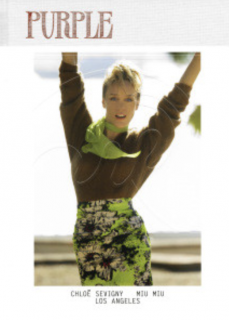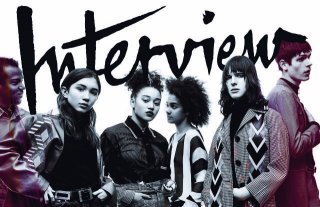Purple’s L.A. Times
The French independent biannual magazine dedicated to fashion, art and culture has themed its latest issue around Los Angeles, its new Stateside base.
by Katya Foreman

Trystin Valentino in Ermenegildo Zegna Couture on one of the Purple covers. Vava Ribeiro
If L.A. is having a moment, Purple is basking in the haze with its latest issue dedicated to the city’s vibrant creative landscape. Personalities featured range from Arrow de Wilde, frontwoman of local glam-punk band Starcrawler, to David Hockney and Kenneth Anger. (Purple cofounder Olivier Zahm tried to get an interview with Elon Musk, but it didn’t work out.)
Personalities featured on the issue’s 12 covers include Kyle MacLachlan in Calvin Klein; Chloë Sevigny in Miu Miu; Dree Hemingway in Armani; Caroline Vreeland in Balmain; Karen Elson in Givenchy, and Trystin Valentino posing with a surfboard in Ermenegildo Zegna Couture.

The Chloë Sevigny cover of Purple’s latest issue. Hans Feurer
Zahm over the past few years has been exploring the cultural variety of L.A.’s neighborhoods, led by his girlfriend, art director and artist Amanda Wall, who introduced him to the city’s east side and Downtown L.A.
“It’s a scene that is changing drastically these days, with a good energy. People feel free in L.A., it’s a natural context for Purple,” said Zahm, who recently set up his new Stateside base in the art district in Downtown L.A. (The editor closed his New York office — a loft untouched since the Seventies next to Grace Church on 12th Street and Broadway that Andy Warhol used to store his furniture collection in — around two years ago after the landlord doubled the rent. He now divides his time between Paris, the magazine’s main base, and L.A.)
It’s all cause for celebration, hence a dinner taking place tonight at Wes Avila’s Guerrilla Tacos in the art district, cohosted by Dover Street Market, which is expected to open a store in the neighborhood soon.
Zahm, who also plans to open a gallery and store in the district early next year with an undisclosed partner, sees it as a new chapter for Purple, which marked its 25th anniversary last year. He acknowledged most people will have to take their car to get there. “You have to drive, take the freeway, it’s an effort to go, but I will do my best to give people a reason to go there. And also tourists — the art district is fun, there are great restaurants, it’s beautiful visually, a lot of tech companies are setting up there,” he said.
He has big ambitions for the space, which he hopes “will be sort of a new Colette, in L.A.” The aim, he added, is to “reinvent the culture of shopping” with a new type of retail experience based on variety and novelty, including exclusive products and collaborations between artists and brands. But Zahm also wants to keep things spontaneous, including the idea of creating an open space for designers and brands from Europe looking to do a presentation in L.A.
Zahm, who carved out a career as a respected art critic and curator before launching Purple in 1992 with Elein Fleiss, is not new to retail. He opened a Purple concept store in the mid-Nineties on Canal Saint-Martin in Paris — “maybe the first concept store in Paris, where we did shows, exhibitions, parties, etc.” — and had a store in Tokyo. He was also the first art director of now-shuttered cult concept store Colette.
“This is the next step for Purple: going back into a physical space to counter-attack the dissolution of fashion in the virtual space and social media, which is not a space for creativity and real communities to exist; it’s a space for commerce and narcissism,” he said.
“This is the future of my magazine, too. I think it’s interesting to combine a biannual magazine with a physical magazine where everything featured in the magazine will find a live dimension. People who read Purple can also experience in real life what we do on the pages,” added Zahm. “It will be real content to experience, original product and original ideas — a Purple see-now-buy-now.”
Certain products may be available online, depending on the quantities, according to Zahm, who is also fascinated by the “vision of the future” that L.A. offers, with the scientific research around areas including artificial intelligence, DNA and space programs. “The future of humanity is robots, it’s already here.”
For Zahm, everything he loved about New York is in L.A. now. “The optimism, a certain innocence, an ambition, a feeling of freedom and experimentation. New communities, and also the beginning of an interesting political activism which is not just fighting against the [Donald] Trump administration,” he said. “It’s more about developing communities and being independent.”
source | wwd




 .
.








